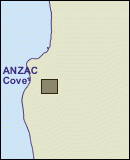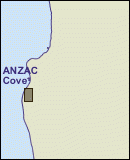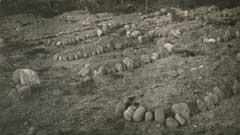Cemeteries on Gallipoli

Brown’s Dip Cemetery

Shrapnel Valley Cemetery Plan

The Beach Cemetery
Tens of thousands of allied soldiers died at Gallipoli. When Christians, Jews or Indian Muslims died, they were buried, whenever possible either in cemeteries or isolated graves behind the front lines. If they died in battle, they were often left where they died as it was too dangerous to collect their bodies. In one instance, in May, an armistice was organised to bury the dead in no man’s land. These men were generally buried in mass graves in old trenches or ditches. Men who died on hospital ships were buried at sea. Sikhs and Gurkhas were often cremated.
Early in the campaign, burying Australian soldiers and recording the burials at Anzac was haphazard, but the situation improved with the establishment of permanent cemeteries and the appointment of Chaplain Walter Dexter to organise the maintenance and recording of the cemeteries.
Dexter supervised the surveyors who made plans of the major cemeteries, Shrapnel Valley, Ari Burnu, the Beach, Brown’s Dip, and Shell Green. Some of the smaller cemeteries were also surveyed, such as at Plugge’s Plateau and Victoria Gully. When it was decided to evacuate Anzac and Suvla in December 1915, they did not know what would happen to the graves. Before the evacuation, Dexter and his team completed the maintenance and surveying of the cemeteries. Dexter kept the burial records up to date and took the bearings of the isolated graves so that accurate and useful records would exist should they return to Gallipoli.
Graves Registration Unit 1919
After the war the newly established Graves Registration Unit (GRU) arrived at Gallipoli. Their job was to locate graves of allied soldiers and identify their remains, find and bury all unburied remains, record the burials and chart the cemeteries. The Australian representative on the GRU was Lieutenant C. E. Hughes, who had served at Gallipoli in 1915. Using the plans made by Dexter’s team and burial reports, Hughes attempted to locate the graves of the allied dead at Anzac Cove.
This was made difficult because many cemeteries had vanished from view. After the evacuation many of the wooden crosses were used as firewood and the grass and shrubs grew back, covering the graves. Other cemeteries had been remodelled by the Turks in 1916 after Pope Benedict XV enquired after the state of the cemeteries. When the Turkish War Office discovered the cemeteries had vanished from view, they made mounds, representing graves, and bordered them with stones. These mounds often faced a different direction to the graves underneath. It did make the cemeteries look tidy, and the Pope’s envoy, who inspected the remodelled cemeteries, reported that the Turks were caring for the cemeteries.
Hughes and his team at first used Dexter’s plans to find graves and they assisted in locating the general positions and directions of the graves; however, they found establishing the exact locations of the graves difficult, as the plans had no map bearings. So within a cemetery, they used metal rods, inserting them in the ground. If the rod could be pushed easily into the ground, this meant the area had been dug. In this manner, Hughes’s team was able to determine whether the area was a grave. This method was time-consuming, but through it Hughes and his team found thousands of graves, including isolated ones.
Imperial War Graves Commission
After the GRU finished its work at Anzac in 1919, responsibility for the graves fell to the Imperial War Graves Commission (IWGC). The IWGC would plan, build and maintain the permanent cemeteries at Gallipoli. The architect for the cemeteries was Sir John Burnet. While many of the cemeteries would remain in their original positions, it was decided that all isolated graves and some cemeteries at risk of erosion or landslides would be moved to safer areas.
By the end of 1924 most of the work on the permanent cemeteries was finished. Each identified man had a headstone, with the unknown buried among them. Not all graves could be identified as containing only one body, so they decided not to give these graves headstones. The areas of green grass over the unknown graves also enhanced the concept of “God’s Acre” – a churchyard or hallowed ground.
Men known to be buried in the cemeteries, but with their actual grave locations unknown, were commemorated on special headstones, which read “believed to be buried in this cemetery”. Those with no known graves, or who were buried at sea, were commemorated on memorials at Hill 60, Chunuk Bair, Lone Pine, and Cape Helles.
These cemeteries and memorials have remained virtually unchanged since the 1920s and are maintained by the Commonwealth War Graves Commission (the IWGC changed its name in 1960). When the cemeteries were first established, it was thought very few people would be able to make the pilgrimage to Gallipoli to visit the graves. Many cemeteries and Memorials were placed where they could be viewed from the sea – by the ships making their way along the coastline and the Dardanelles Strait. Today, however, tens of thousands of people do make the journey to Gallipoli to remember those who served and died there.

Beach Cemetery in 1919 as remade by the Turks in 1916
Lieutenant Cyril Hughes and Sergeant Woolley marking out graves at Brown's Dip Cemetery in 1919



